I’m supposed to be climbing a volcano somewhere in the Indonesian wilderness right now, but instead I’m guiding two Indonesian dermatologists up the steep hills of the Mid-levels area on Hong Kong in search of the city’s oldest mosque.
Unable to use the escalator system to ascend the hill because of the previous night’s typhoon, they were out of breath when we reach our destination. Wawan goes inside and prays, while Andreas, who is among Indonesia’s 3 percent Catholic population, stays outside and snaps photos.
A plane malfunction in Taipei a day earlier had caused us to miss our connecting flight from Hong Kong to Surabaya, Indonesia’s second-largest city. We were put on the next day’s flight, which was delayed by 19 hours because of the typhoon. I lost two full days of my trip, but I made two new friends and was able to learn directly from locals about my destination and its culture.
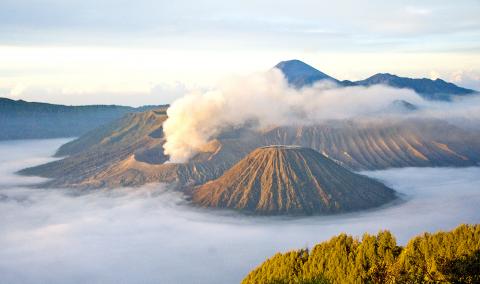
Photo: Han Cheung, Taipei Times
I had decided to book the trip pretty much on a whim after seeing a photo of the stunning crater lake of Ijen, located on the eastern tip of Java island. The place is also accessible from Bali, but hoping to avoid tourist hordes I chose Surabaya as my exploration base, a place deemed by Lonely Planet Indonesia to be “slim” in attractions.
I love looking at cities and how everyday people live in them as much as I like visiting natural wonders. And yes, the volcano was unforgettable — but Surabaya, despite its rather unattractive, exhaust-filled congested streets, is charming in its own way with a proud history.
Wawan takes me to lunch with his wife, grandson, driver and maid once we finally land. It’s a greasy meal — fried fish, fried chicken, fried shrimp crackers, a tofu dish and a rather oily beef soup. No vegetables. Wawan eats with his hands, grabbing the food with the tips of his fingers, and says people also use utensils. I try, but the food keeps falling out of my hand. Local food for the next few days turns out to be in the same vein — fried, sweet and consisting mostly of meat, soy and rice. I snack on chicken skewers and tofu with sweet-and-sour sauce and chilies, and devour bebek goreng (fried duck) at a street joint named Donal(d).
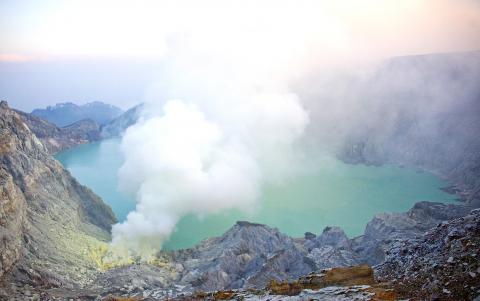
Photo: Han Cheung, Taipei Times
SURABAYA ON FOOT
The first thing you learn to do in Surabaya is cross the wide, multi-laned streets that are choked with unyielding cars and motorcycles, and very few traffic lights. You simply walk into the chaos with your hand stretched toward oncoming traffic, making an up and down waving motion. Surprisingly, the cars and motorcycles slow down and let you pass.
After mastering this skill, I spend the first afternoon wandering the city on foot. Wawan says Surabayans are not big on walking, and it is evident in the lack of sidewalks or the ones full of giant holes. There’s virtually no public transportation, but plenty of taxis, motorbikes and vans will sometime stop and offer rides to pedestrians.

Photo: Han Cheung, Taipei Times
I first head toward the cloistered corridors and lush courtyards of the Hotel Majapahit. It began as the Hotel Oranje under Dutch rule in 1911, and was the site of the famous “flag incident” where young Indonesian revolutionaries ripped off the blue part of the Dutch flag to make the red-and-white Indonesian flag. Just five minutes walk from my cheap hotel, it was a pleasant place to hang out and pretend that I owned the place.
Due to the lack of sidewalk and suffocating smog, I detour to a small river path, lined with street vendors and quaint, crumbling houses with orange tile roofs. I notice that perpendicular to the path are gated alleyways, which I later learn are called kampungs — intimate webs of tiled walkways that are locked to the main roads during the night. Life is happening in there — people sitting on benches and chatting, schoolchildren playing, vendors setting up shop. A few curious residents ask me where I’m from, but most of them walk straight past. I sit down on a bench and soak in the tranquility before venturing back into the jungle.
I met Aan at the House of Sampoerna, arguably Surabaya’s only “presented” tourist attraction where you can watch workers hand-roll clove cigarettes at a speed of more than five per minute. Aan says he’s a tour guide and he can show me “interesting places” on his motorbike for a small fee. For the next two days, he brings me to places I would not have found on my own — from the Arab market of Ampel to the sleepy harbor of Kalimas to the crowded Bungkul park, where teens hang out and lovers canoodle.

Photo: Han Cheung, Taipei Times
I visit his house, a dilapidated one-bedroom in a kampung and hang out with his family, sipping ultra-sweet ice tea while Aan chain-smokes clove cigarettes. Islamic prayer music can be heard virtually everywhere upon sunset, and at Aan’s place we hear his neighbor belting off-key religious songs into a microphone.
The shopkeeper laughed when I walked into a Circle K my first night and asked where the beer section was. Apparently, in addition to the 2014 shuttering of Dolly Lane, reportedly Southeast Asia’s largest red light district, Surabaya mayor Tri Rismaharini also banned the sale of alcohol in minimarts and most supermarkets.
Aan shows me where the beer is — of course it’s in a Chinese supermarket. We sit outside and drink Bintang, a local pale lager, when his friend walks by. Aan asks him to join us, but he declines.
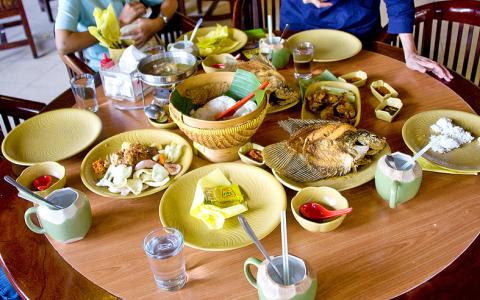
Photo: Han Cheung, Taipei Times
“He says he doesn’t drink — he is a very religious Muslim,” Aan says as he takes a swig. “I am just a regular Muslim.”
THE VOLCANOES
I set out for the Ijen crater lake around 1pm with a driver recommended by Wawan. It’s possible to do it by public transport, but most people take a car from either Bondowoso or Banyuwangi to the base camp where the hike begins.
The gate opens at 1am, and people start hiking immediately to reach the bank of the crater lake and see the famed blue fire — which arises from ignited sulfur — bursting through cracks in the rock. You can rent a gas mask before you begin the descent into the crater.
It’s quite an arduous hike, and dangerous too — there are no railings to prevent your fall straight into the abyss. It takes about an hour to make the 3km trek to the tea-house, and another 30 minutes to the rim. From there, I make a perilous descent into the crater, where hundreds of tourists — mostly Indonesian — have already gathered, snapping photos of the fire and the sulfur miners who carry their 60kg to 80kg loads up and down the mountain.
The blue fire was spotty and not as impressive as I had imagined, and the massive amount of visitors put a damper on the wonder. But as I climb back up to the crater’s rim, the sun rises — and the majestic, wind-scarred landscape with the turquoise-blue center appears out of nowhere — yes, this is why I came here in the first place.
I find out later that there’s an even more famous volcano, Mount Bromo, the star attraction of East Java. I ride there with Aan, arriving at the village of Ngadisari around 2am. After some coffee, we set out by jeep toward Mount Penanjakan to watch the sunrise on a packed viewing platform.
After much jostling for position and ducking under selfie sticks, the view that unfolded — the fuming mouth of Bromo and other peaks, surrounded by a sea of clouds, was otherworldly. Bromo and its siblings sit inside a much larger volcanic depression that contains the clouds, hence the landscape.
We descend into the depression, a dusty, moon-like volcanic plain dubbed the “sand sea.” Here, horsemen offer rides to the volcano — passing by a Hindu temple complex where villagers gather once a year to make offerings to the fiery peak — but I elect to walk. It’s a steep but short climb up Bromo, where you can stare directly into its fuming mouth. There are no railings here either — don’t end up as a sacrifice.
I stare out toward the vast landscape, which ends at the steep crater walls. I came here for one volcano, ended up climbing two, and the rest of the trip went almost nothing as planned — and that’s the beauty of traveling alone.
Before I leave, Wawan and his wife take me out for food and kopi luwak, or coffee made from beans eaten and defecated by a civet. As I sip on the NT$300 cup of coffee, I think of Aan, who could not even afford a cup of Starbucks a day earlier. I watch two women in hijabs gleefully sing love songs on the coffee shop’s karaoke stage. It really is a land of contrasts, and I’m glad to have experienced it all in the least touristy way possible.
PACK YOUR BAGS
Getting there and around
◆ Eva Air and China Airlines fly daily directly to Surabaya. Cathay Pacific is cheaper but there is a transfer in Hong Kong. Tickets range between NT$9,000 and NT$15,000.
◆ Surabaya is a sprawling metropolis, not exactly pedestrian friendly, however taxis, motorcycles and vans are readily available. Uber is also popular.
What to do
◆ Wander the older part of Surabaya in the north, featuring Kalimas harbor, the cigarette museum of Sampoerna House, Chinatown and the Arab market of Ampel. Explore the tranquil residential areas and sample local cuisine, which can be found on every corner.
◆ Visit Bromo Tengger Semeru National Park and climb to the rim of Mount Bromo, an active volcano. An tour from Surabaya for one person costs between NT$3,000 and NT$4,000; a cheaper alternative is to take the bus to Probolinggo (about NT$70, up to three hours) and book a tour from there. Tours are easily found online by searching “bromo tour” or visiting the local tourism office. It is possible to do the whole trip by yourself if you have the time and energy.
◆ Climb the crater lake of Ijen. The closest town from Surabaya is Bondowoso (NT$120, five hours by bus), where tours can be organized or transportation arranged.
Where to stay
◆ Accommodations are plentiful, ranging from the budget Citihub Hotel (NT$500 to NT$800 per night depending on amenities, www.citihubhotels.com) to the luxurious Hotel Majapahit (about NT$3,000 per night, hotel-majapahit.com).
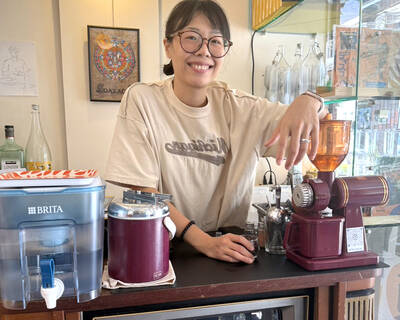
Cheng Ching-hsiang (鄭青祥) turned a small triangle of concrete jammed between two old shops into a cool little bar called 9dimension. In front of the shop, a steampunk-like structure was welded by himself to serve as a booth where he prepares cocktails. “Yancheng used to be just old people,” he says, “but now young people are coming and creating the New Yancheng.” Around the corner, Yu Hsiu-jao (饒毓琇), opened Tiny Cafe. True to its name, it is the size of a cupboard and serves cold-brewed coffee. “Small shops are so special and have personality,” she says, “people come to Yancheng to find such treasures.” She
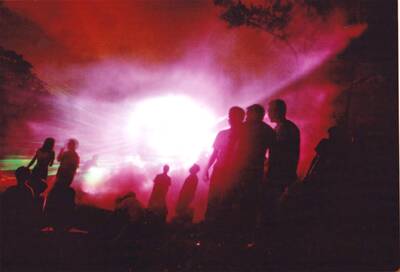
In July of 1995, a group of local DJs began posting an event flyer around Taipei. It was cheaply photocopied and nearly all in English, with a hand-drawn map on the back and, on the front, a big red hand print alongside one prominent line of text, “Finally… THE PARTY.” The map led to a remote floodplain in Taipei County (now New Taipei City) just across the Tamsui River from Taipei. The organizers got permission from no one. They just drove up in a blue Taiwanese pickup truck, set up a generator, two speakers, two turntables and a mixer. They

Former Chinese Nationalist Party (KMT) chairwoman Hung Hsiu-chu’s (洪秀柱) attendance at the Chinese Communist Party’s (CPP) “Chinese People’s War of Resistance Against Japanese Aggression and the World Anti-Fascist War” parade in Beijing is infuriating, embarrassing and insulting to nearly everyone in Taiwan, and Taiwan’s friends and allies. She is also ripping off bandages and pouring salt into old wounds. In the process she managed to tie both the KMT and the Democratic Progressive Party (DPP) into uncomfortable knots. The KMT continues to honor their heroic fighters, who defended China against the invading Japanese Empire, which inflicted unimaginable horrors on the
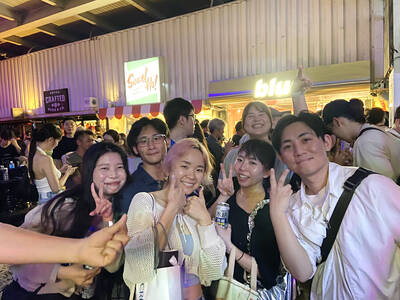
Hannah Liao (廖宸萱) recalls the harassment she experienced on dating apps, an experience that left her frightened and disgusted. “I’ve tried some voice-based dating apps,” the 30-year-old says. “Right away, some guys would say things like, ‘Wanna talk dirty?’ or ‘Wanna suck my d**k?’” she says. Liao’s story is not unique. Ministry of Health and Welfare statistics show a more than 50 percent rise in sexual assault cases related to online encounters over the past five years. In 2023 alone, women comprised 7,698 of the 9,413 reported victims. Faced with a dating landscape that can feel more predatory than promising, many in